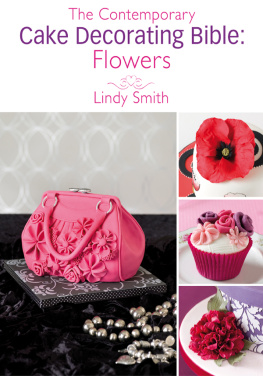CAKE DECORATING WITH THE KIDS:
Halloween
Jill Collins & Natalie Saville
Basic Tools and Equipment
If you enjoy baking and cake decorating, you probably already have all the equipment you need for the projects in this book, and more besides. The lists that follow provide details of everything you need and can be dipped into as part of the basic equipment listed in every project.
BAKING EQUIPMENT
- Kitchen scales accurate weighing of ingredients is essential
- Measuring spoons for measuring small quantities
- Mixing bowls for mixing ingredients
- Wooden spoons and spatulas for mixing and folding
- Electric mixer makes short work of all your baking but if you dont have one, you can always use a mixing bowl, a wooden spoon and a bit of elbow grease!
- Cake tins (pans)/cupcake tins/baking trays for baking cakes, cupcakes and cookies
- Greaseproof (wax) paper or re-usable baking parchment for lining tins (pans) and melting sweets
- Cupcake cases a variety of styles to suit your projects
- Wire cooling rack for resting cakes and cookies as they cool
CAKE DECORATING EQUIPMENT

- Rolling pins large and small, for rolling out sugarpaste and petal paste
- Small non-stick plastic board for rolling small amounts of sugarpaste and petal paste
- Plastic dowels for supporting tiered cakes
- Edible pens for marking dowels and for quick-and-easy decoration
- Paintbrushes a variety of different sizes are useful for painting and sticking
- Edible glue for sticking small pieces of icing together
- Piping (pastry) bags small for piping royal icing and large for piping buttercream
- Cutters a variety of shapes and sizes are useful for different projects
- Chocolate moulds for creating fun and easy chocolate decorations
- Drying mat a great place to dry small sugarpaste pieces and cut-out shapes
- Piping tubes (tips) also known as nozzles, a variety of different types and sizes are useful for filling, piping and decorating cakes
- Palette knife for lifting delicate sugarpaste pieces
- Paste food colourings and edible glitters
- Craft knife for accurate detailed cutting
- Cocktail sticks (toothpicks) great for adding tiny amounts of colour
- Sugar shaker for dredging icing (confectioners) sugar onto your surface to prevent sticking
- Sprinkles for easy decoration
- Icing smoother for smoothing cakes that are covered in sugarpaste

Safety in the Kitchen
Baking and decorating cakes with kids is enormous fun for everyone but of course when working with kids it is always important to make sure that they understand the importance of being safe in the kitchen.
Rules and Regs
Food safety is a constantly evolving subject, with new rules and regulations being brought in all the time. An example of this is that edible glitter, while non-toxic and completely harmless, has recently been classified as a non-food item, and is therefore not recommended for consumption. We therefore advise removing all glittered objects before eating your cakes.
Tips to Help Stay Safe
- Wash hands thoroughly with soap and water before starting and often during each decorating session, as its almost impossible to resist putting little chocolately fingers in mouths!
- Make sure all surfaces, bowls and utensils are clean and dry.
- Read the whole recipe before you begin there are often really good tips at the end!
- Keep pets out of the kitchen.
- Tie up long hair and wear an apron to keep clean and avoid transferring germs to food.
- Clean up as you go an excellent discipline to learn as this avoids accidents caused by spills and prevents foreign bodies finding their way into the food.
- Always ensure an adult uses the oven and handles any hot tins (pans).
- Make sure all cakes and cookies are completely cool before decorating, as icing melts very easily!
- Be vigilant when using knives sharp knives are often not necessary, other than for carving cakes or cutting around templates, and these aspects are best done by an adult or much older child. For cutting sugarpaste, use old-fashioned flat-bladed bone-handled knives or plastic pointed knives, which are safe for children to use. As a general rule though, children should always be closely supervised when using knives or scissors in the kitchen.

Recipes, Fillings and Toppings
Recipes
We are firm believers that a cake should taste as good as it looks and it should look amazing! All these recipes have been meticulously tried and tested and always produce fantastic results if followed carefully, ensuring that you will be absolutely thrilled when you bite into your creations.
CLASSIC VANILLA SPONGE CAKE
This deliciously light yet moist sponge cake is a must in any bakers repertoire. It is so simple to make and always produces excellent results. It is also very easily adapted to produce other classic flavours (see ).
Ingredients
275g (9oz) unsalted (sweet) butter, softened
275g (9oz) caster (superfine) sugar
5 medium eggs
5ml (1 tsp) vanilla extract
275g (9oz) self-raising (-rising) flour
Preparation time: 20 minutes
Baking time: 5560 minutes
Makes: 20cm (8in) round cake or 2024 cupcakes
1 Preheat the oven to 180C (350F / Gas 4).
2 Grease and line a 20cm (8in) round tin (pan) with a little softened butter and baking parchment.
3 Cream together the butter and sugar until light and fluffy using an electric whisk or freestanding mixer.
4 Add the eggs one at a time, beating well between each addition. Add the vanilla extract.
5 Sift the flour into the mixture and fold in gently with a large spatula until incorporated.
6 Tip the mixture into your prepared tin (pan) and level the surface with the back of a spoon.
7 Bake for approximately 55 minutes or until a skewer inserted into the centre of the cake comes out clean.
8 Allow to cool in the tin (pan) for 5 minutes before transferring to a wire rack to cool completely.




















